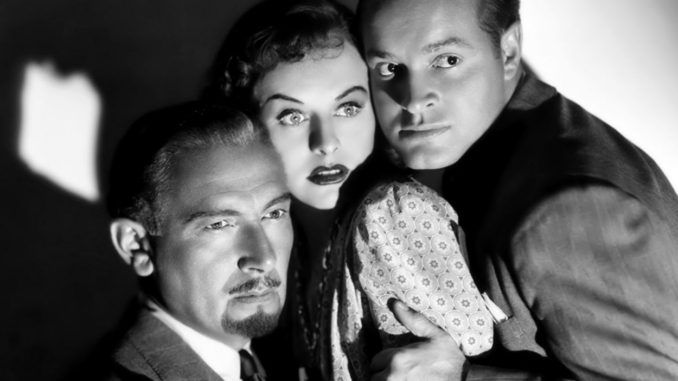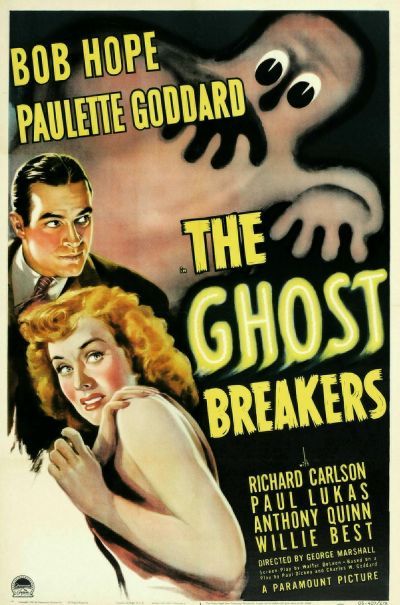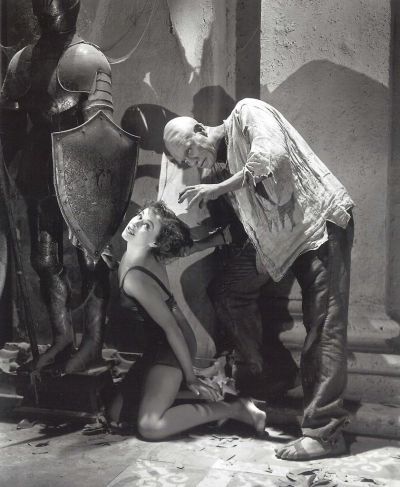
Rating: C+
Dir: George Marshall
Star: Bob Hope, Paulette Goddard, Anthony Quinn, Willie Best
Vintage horror-comedy was not the sole property of Lou Abbott and Bud Costello, even if movies like Abbott and Costello Meet Frankenstein have attained classic status. It has been around for almost as long as horror, certainly before cinema. Regardless of whether you consider horror fiction as beginning with Mary Shelley’s Frankenstein, or the Gothic approach of The Castle of Otranto, as soon as these came out, there were parodies of them being published. You don’t have to know any more about Mrs. F.C. Patrick’s 1798 novel than its title – More Ghosts! – to understand it isn’t taking its topic with the utmost seriousness.
The first original literary work to combine the two genres might be Washington Irving’s The Legend of Sleepy Hollow. Published in 1820 (and written in, of all places, Birmingham!), it establishes some of the tropes still popular in horror-comedy now, with its broadly-drawn characters and situations which appear ludicrous if you take them at face value. Where novelists led, playwrights would eventually follow, and that keads to our topic here. For The Ghost Breakers was based on a 1909 play, using the singular rather than the plural, written by by Paul Dickey and Charles W. Goddard. It enjoyed a ten-week run on Broadway in the spring of 1913, starring H. B. Warner (later the pharmacist in It’s a Wonderful Life, and Katherine Emmet. Warner reprised his role for a 1914 silent adaptation, directed by Cecil B. De Mille, but both it and another silent version, in 1922 with Wallace Reid and Lila Lee, are regarded as lost.
 Which brings us to this version, written by Walter DeLeon, who had also worked on the 1922 version. The main change is in the female lead. While both inherit a haunted estate, in the original play and earlier adaptations, the heiress was a Spanish princess, Maria Theresa. Here, she’s much more down home: “Poor working girl, honest but tough,” as Mary Carter (Goddard) describes herself, and certainly not aristocratic. The male lead is also changed, albeit to a lesser degree. In both, they are men caught up in a murder, who hides out in the heroine’s room, subsequently going with her to help out with her new property. In this case though, Larry Lawrence (Hope) is a radio host who is entirely innocent, albeit keen to escape the ire of the mob, after discussing topics on his show they did not want public.
Which brings us to this version, written by Walter DeLeon, who had also worked on the 1922 version. The main change is in the female lead. While both inherit a haunted estate, in the original play and earlier adaptations, the heiress was a Spanish princess, Maria Theresa. Here, she’s much more down home: “Poor working girl, honest but tough,” as Mary Carter (Goddard) describes herself, and certainly not aristocratic. The male lead is also changed, albeit to a lesser degree. In both, they are men caught up in a murder, who hides out in the heroine’s room, subsequently going with her to help out with her new property. In this case though, Larry Lawrence (Hope) is a radio host who is entirely innocent, albeit keen to escape the ire of the mob, after discussing topics on his show they did not want public.
He ends up secreting himself in Mary’s trunk, and coming out on the ship to Havana. I guess in the forties, stowaways were able to upgrade to a cabin with space for their manservant, Alex (Best). It’s worth discussing the Larry-Alex relationship a bit. While obviously an employer-employee one, it comes over as surprisingly friendly and informal, especially since Alex is an African-American. There are some lines which have not aged particularly well, just as Larry saying to Alex after the lights go out, “You look like a black out in a blackout. This keeps up, I’m going to have to paint you white.” But in terms of character, and making allowances for the comedic tone, I’ve seen a lot worse.
Once everyone arrives in Cuba, the horror elements show up – such as they are. They’ve been notable by their almost complete absence to this point, nobody even noticing the name of Mary’s new estate is Castillo Maldito, which literally translates as “castle of evil” (and was the film’s title in Hispanic territories). It gradually becomes clear someone is attempting to frighten Mary out of her inheritance. Larry, the titular ghost breaker – or as he explains, “I explain mysteries that people don’t want explained” – is having none of it. If you reckon this is closer to an episode of Scooby-Doo… you’re not wrong. Certainly, the comedy is given far higher priority than the horror, though there’s a surprisingly impressive scene where Mary is stalked through the castle by a zombie (below), played by Noble Johnson, who was the chief of Skull Island in King Kong.
This being the forties, it’s an old-school version of a zombie, rather than the Romero model. I did wonder whether the makers were aware that Cuba was not Haiti. Hey, one Caribbean island is pretty much the same as the other, am I right? Though this does set up the film’s best line, when subject expert Geoff Montgomery is explaining what the creature is to Larry. “A zombie has no will of his own,” he says. “You see them sometimes walking around blindly with dead eyes, following orders, not knowing what they do, not caring.” To which Larry replies, “You mean, like Democrats?” Eighty-five years after this was released, it appears the more things change, the more they remain the same. Feel free to change the party as you see fit.
 It’s when the dialogue is crackling like that, the film is most entertaining. For example, this exchange between Larry and Alex
It’s when the dialogue is crackling like that, the film is most entertaining. For example, this exchange between Larry and Alex
Alex: Hey, boss, you ain’t goin’ upstairs, are ya? Where those ghosts is?
Larry: You stay there, and if a couple a fellas come runnin’ down the stairs in a few minutes, let the first one go. That’ll be me.
Alex: If somebody passes you, that’ll be me.
Interesting to see Hope as at least a somewhat heroic character in this, and a genuinely smart one to boot. You can see why Dan Ackroyd found inspiration here when writing Ghostbusters.
But my tastes prefer the balance of horror-comedies to be skewed more towards the horror side – or, at least, not so overwhelmingly leaning to the humourous. Outside of the zombie scene mentioned above, there is one (1) genuine ghost, and a lot of heiress-intimidating shenanigans. As a comedy, it’s effective enough: Hope and West clearly know about timing, and how to deliver a line to get the best results. Still, there’s little here to make it stand out from any other screwball comedy of the time, and once you get beyond that pair, things drop off sharply in interest. Except for Goddard and her nice pair of gams – considering the era, we see what feels like a surprisingly amount of them!
This article is part of our October 2025 feature, 31 Days of Vintage Horror.
